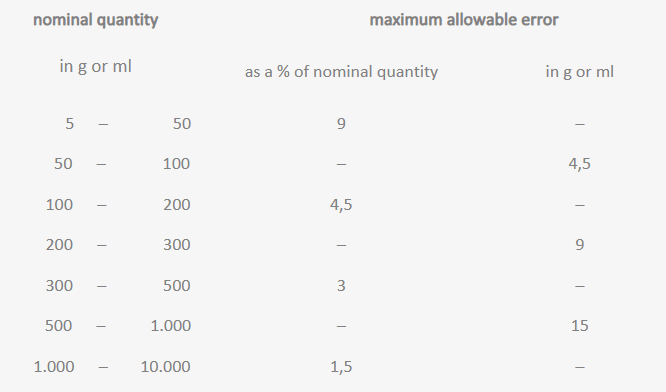
By examining your filling system from a metrological perspective, you gain the most refined and optimal efficiency.
Optimal process design: e-marking system, specifications, and measuring systems.
Expertise
Our expertise and experience with e-marking make us the best partner to accelerate market access for manufacturers and help end-users in optimizing their measuring systems. We guide you through testing, certification, training, knowledge, and leverage our international reputation.
Information on establishing a quality system
According to the Warenwet (Commodities Act), pre-packaged consumer products sold by weight (in grams or kilograms) or volume (in milliliters or liters) must display a declaration on the packaging indicating the quantity of product contained inside. Under Dutch legislation, all packages must contain at least the amount stated on the label. However, e-marking on the packaging implies that the packages contain the average indicated quantity of product (within the limits), resulting in valuable cost savings.

FAQ (DUTCH)
A packager fills portioned packages that do not display a nominal quantity. The packager checks the product weight using a checkweigher. The question is: does it need to be calibrated?
Examples of packages without a nominal quantity include cases where the product quantity is less than 5g or ml (except for spices and herbs) or when the package is not intended for individual sale and is part of a collective package (e.g., a packet of croutons in a meal salad).
If a checkweigher is used to verify the accuracy of a quantity claim on a package, it constitutes a commercial transaction and therefore the checkweigher must be calibrated. This requirement applies even if the checkweigher is used to sort boxes that contain an insufficient number of items (e.g., 4 ice creams instead of 5). This matter has been addressed in a ruling by the administrative court.
According to the relevant regulations for weighing instruments (MID), it can be inferred that a package without a nominal quantity may be checked using a non-calibrated checkweigher. However, this exception does not apply if the declaration of product weight is made elsewhere for such packages (e.g., on a collective package, outer box, or a third-party label).
A manufacturer supplies unpackaged products and packaging materials to a contract packager who performs the packaging on behalf of the manufacturer. The label displays the nominal quantity, the e-mark, and the name of the manufacturer.
According to the European Directive, it is the packager who is responsible for ensuring that the e-prepackages comply with the requirements of that Directive (paragraph 1, article 4, Annex I). A packager is defined as the one who fills e-prepackages in the course of a business established in the Netherlands (article 1.1, Warenwetbesluit). Furthermore, article 5.1 of that Decree states that the packager must have an approved e-mark system.
Since the name of the manufacturer appears on the label, they are considered a “company having the filling carried out” (article 3.2 of Annex I of the European Directive). These companies are only mentioned in the section on identification and do not have any further responsibilities regarding the compliance of the e-prepackages with the requirements.
The terms TU1 limit and TU2 limit are not mentioned in the regulations but are commonly used (although some also refer to them as To limit, T1 limit, Tabs limit, and T2 limit).
The regulations refer to the maximum allowable error and how it can be calculated:

The TU1 limit can be calculated by subtracting the maximum allowable error from the nominal quantity, and the TU2 limit is determined by subtracting twice the maximum allowable error from the nominal quantity.
You may have come across “Class A” and “Class B” in European Directive 76/211/EEC, which specify different maximum allowable errors. In the 1976 version of the Directive, these classes were indeed present but were removed in 1978. The version with all the amendments made over the years is available at the end of the same website of the European Union (“All consolidated versions”).
A measuring instrument must comply with the requirements of the Metrology Act (“be calibrated”) and be suitable for its intended purpose. Accuracy is one of the factors that play a role in this.
From the regulations, it can be deduced that the error in measuring the quantity of a product must not exceed 1/5 of the maximum allowable error of the nominal quantity.
Based on this, the following relationship between the nominal quantity and the verification unit (e) of scales was established in 1980:
| nominal quantity of the prepackaging | verification unit (e) of the scale |
| 5 g or ml or higher | 0,1 g or smaller |
| 15 g or ml or higher | 0,2 g or smaller |
| 35 g or ml or higher | 0,5 g or smaller |
| 125 g or ml or higher | 1,0 g or smaller |
| 350 g or ml or higher | 2,0 g or smaller |
| 1.750 g or ml or higher | 5,0 g or smaller |
| 3.500 g or ml or higher | 10,0 g or smaller |
| 7.000 t/m 10.000 g or ml | 20,0 g or smaller |
This means that the indication of a scale with a verification unit of 1g can be accepted without further correction for nominal quantities starting from 125g. It also means that a scale with a larger verification unit can be used if the measurement result is corrected.
Other aspects that fall under “suitable for the intended purpose” include:
Regular calibration Method of recording measurement results (if the scale has that capability) Reject mechanism or other means to distinguish rejected prepackagings from approved ones (in the case of checkweighers) Guarantee that all dosed product goes into the packaging and that the machine stops if no combination can be made (in the case of multiheads) Correct functioning of software calculations used by the packager for assessing the acceptance or rejection of batches with prepackagings, and correct functioning of algorithms that control the acceptance or rejection of individual prepackagings.
A packager delivers individually packaged bags of chips in a large bag. On that bag, they write: 10 x 30 g net weight = 300 g. What is the right approach? Unfortunately, there’s no short answer.
A multipack is a prepackaging containing two or more packaged products or a product and one or more packaged products/ingredients.
It is wise to declare only the nominal quantity that is legally required.
What is legally required?
Different laws and regulations for various product types impose requirements for declaring product quantity on multipacks. This applies to food, cosmetics, chemicals, and similar items.
In general, if the individual packages within the multipack are intended for separate sale, the number of units and the quantity per unit should be stated on the multipack.
If the individual packages within the multipack are not intended for separate sale, then the number of units and the total quantity should be indicated.
This also applies when a prepackaged product includes a packaged ingredient, such as packets of cheese, croutons, and sauce in meal salads.
Special cases
A legal ruling states that portioned packages of honey sold or provided by caterers as part of a meal are considered prepackaged. There is good reason to extend this to portioned packages of other products as well. For example, a box of sugar packets should state: “1000 units, 5g each.” The sugar packets themselves should also be labeled with a nominal quantity. If an e-marking is used, it should be repeated on the multipack.
If the number of packages contained within the multipack is visible from the outside, indicating the number of units may be omitted.
If the total nominal quantity of all packages within the multipack is visible from the outside, indicating the quantity on the multipack may be omitted.
The European Commission has stated that if the exact number of units is not known due to “filling technical” reasons, an estimated quantity may be declared (e.g., “approximately 1000 units”). However, not all countries in the European Union have adopted this and may require the minimum number instead.
What if multiple nominal quantities are indicated?
Some packagers choose to declare both the nominal quantity of the individual packages and the total nominal quantity on the multipack. Additionally, the nominal quantity may be indicated in both volume (ml, cl, or l) and mass (g or kg) on the multipack.
All nominal quantities indicated on a multipack must be accurate. If an e-marking is used, it applies to all nominal quantities, even if it is clearly associated with one specific quantity. All these quantities must be included in the e-marking recognition.
Who is responsible?
The packager is responsible for ensuring that the prepackagings meet the requirements, including the multipack.
Exception: If someone assembles a multipack using prepackagings that already have a nominal quantity, packager identification, and an e-marking, which are intended for separate sale, and they do not declare a total quantity, then the packager of the prepackagings within the multipack is responsible for ensuring compliance with the requirements.
This means that the packager of meal salads who purchases ingredient packets is responsible for the total quantity of the product they need to declare. They must come up with a solution for dealing with the variation in the quantity of the purchased packets.
Example of incorrect declaration
It is incorrect to declare the quantity of products in packages that are not intended for separate sale on the multipack (e.g., on the box: “10 packets of instant soup, 19g each”). The number of units and the total weight must be stated on the multipack.
A packager fills ketchup and expresses the nominal quantity in grams. Germany prefers milliliters. What should the packager do?
The general rule is simple: liquid products should be indicated in a unit of volume (ml, cl, or l), while all other products should be indicated in mass (g or kg).
It is the exceptions in the e-marking Directive that complicate matters: if a Member State has regulations that prescribe otherwise, or if there is a trade tradition that differs, the packager must follow that requirement.
It is not clear which trade traditions exist, and sometimes the regulations in Member States are different. This is the case with ketchup. In such instances, packagers sometimes express the nominal quantity in both units. One is the “mandatory” unit, and the other is the “non-mandatory” unit in one country and vice versa.
Both the “mandatory” and “non-mandatory” nominal quantities must be accurate. If there is an e-marking, it applies to both nominal quantities, even if the e-marking is clearly associated with one of the nominal quantities. All these quantities must be included in the e-marking recognition.
In combination with a multipack, there can be up to 4 nominal quantities indicated on a prepackaging!
A packager is supplying a German customer who requested that a checkweigher ensures that the percentage between TU1 and TU2 does not exceed 2%. In the Netherlands, we use 2.5%. Where does the difference come from, and which is decisive? The short answer: due to the free movement of goods in Europe, packagers filling in the Netherlands can adhere to 2.5%, even if Germany uses 2%.
It concerns the interpretation of this requirement in 76/211/EEC, Annex 1.3 (freely translated): the number of units in a batch of e-prepackaged goods with a product quantity between the TU1 limit and TU2 limit should be small enough for that batch to pass the legal inspection sample.
When the regulations were established, checkweighers did not exist, and almost all packagers used a sampling system. This system had to be robust enough to detect batches that did not comply. The risk of erroneously approving a faulty batch plays a role here. This was and continues to be assessed during the recognition of the e-marking system and all related aspects.
In almost all European countries, the interpretation was as follows: if the number of prepackaged units with a product quantity between the TU1 limit and TU2 limit in a batch is no more than 2.5%, then the risk of erroneously approving it is small enough. Some countries opted for 2%. Which side is correct is a matter for statisticians.
One of the purposes of the e-marking was to regulate free trade between Member States at a time when free trade did not yet exist. This was achieved through the recognition of the packager and inspection at their premises by the Member State where the packager is established. Consequently, inspection in the destination Member State is no longer necessary.
In addition, legal judgments on free trade within the EU and treaties have stipulated that when a product is legally on the market in one Member State, it is also allowed on the market in another Member State. There are, of course, exceptions, but the difference between 2.5% and 2% has not yet been legally tested against this.
The above aligns well with requirements regarding product quantity in standards for, for example, food safety. These standards state that a certified company must comply with the legal requirements. With e-marking recognition, the packager can demonstrate compliance, including the 2.5% percentage used in the Netherlands, without additional requirements.
In the European Union (and other countries with which the EU has a trade agreement), e-prepackaged goods can be freely traded. After Brexit, are e-prepackaged goods from the United Kingdom also allowed to be freely traded?
The trade agreement between the European Union and the United Kingdom does not cover e-prepackaged goods. As a result, anyone purchasing e-prepackaged goods from the UK becomes an importer with associated responsibilities.
Brexit has consequences for Dutch companies that want to bring e-prepackaged goods from the United Kingdom to the Dutch or European market.
Since the United Kingdom is now considered a “third country” after Brexit, responsibilities change. Until 31 December 2020, it was the responsibility of the British packager to ensure that e-prepackaged goods met the requirements. From 1 January 2021, that responsibility lies with the Dutch importer.
The importer can fulfill their responsibility in two ways:
- The importer conducts their own measurements and inspections to ensure that the e-prepackaged goods comply before further trading. For this, the importer needs an accredited e-marking system, which can be requested from NMi (via e-merk@nmi.nl).
- The importer requires a declaration as evidence that they have sufficient guarantees to assume responsibility. This declaration must be requested from NMi (via e-merk@nmi.nl).
Before issuing such a declaration, NMi conducts an investigation into the quality of the evidence and guarantees. NMi then provides advice on the suitability of that evidence and guarantees, which can lead to the issuance of such a declaration.
Regular procedure:
The importer can submit any type of evidence and guarantees to NMi, but typically, it includes the following information:
- Importer’s details in the Netherlands
- Packager(s)’ details in the non-EU country
- Description of the e-marking system of the packager(s)
- Assessment of the proper functioning of the e-marking system of the packager(s) by NMi or another independent qualified third party
The importer can request an “application form for import from a third country” from NMi (via e-merk@nmi.nl).
The processing time for the application is approximately 1 month.
For Brexit, there is an expedited procedure:
The application for such a declaration can follow an expedited procedure if the importer provides the following evidence and guarantees with their application:
- Importer’s details in the Netherlands
- Packager(s)’ details in the UK
- Initially, no description of the e-marking system of the packager(s) in the UK
- Visit report not older than 1 year from the local British Trading Standards Service (TSD), indicating that the e-marking system of the packager(s) complies with:
- the Weights and Measures (Packaged Goods) Regulations 2006; and
- Guidance v.4 from December 2015.
If there is no visit report or if it is older than 1 year, the application will follow the regular procedure.
The importer can request an “application form for the expedited Brexit procedure” from NMi (via e-merk@nmi.nl).
With the expedited procedure, the importer can import one year after the visit from the Trading Standards Service. If no trade agreement with the EU is reached during this period, there is time to initiate and complete the regular procedure.
Once all information is complete, the processing time for the expedited procedure is approximately 10 working days.
Packagers are best advised to inquire with their recipients.
The requirements in countries outside of Europe vary. Sometimes they are very similar to those of the e-marking, and sometimes the quantity of product in each prepackage must be at least equal to the quantity stated on the label.
The best source of information for packagers is typically the recipient they are supplying to (the importer in the destination country).
A packager wondered whether their e-prepackages should comply with “our” e-marking requirements or with the requirements of the destination country. The short answer is that it should meet the requirements of the destination country.
For prepackages intended for a country outside the European Union with which the EU does not have a trade agreement (referred to as a “third country”), they must comply with the requirements of that country, whether or not it includes e-marking in its regulations. It is important to note that if these e-prepackages find their way back into Europe through indirect routes, the responsibility lies with the packager.
Typically, the destination country enforces these requirements through the importer in their country, who conducts the inspection.
Some countries combine this with certification of the importer, which partially relies on what the packager in the Netherlands does to ensure that their prepackages meet the specifications.
For e-prepackages, it can sometimes be advantageous if the packager’s e-marking system has recently been recognized. Some packagers apply for annual recognition of their e-marking system for this reason. This, along with the results of inspections on imported products, can lead to an adjusted regime of import controls.
In all cases, it is the authorities of the third country that determine the exceptions and/or conditions that apply.
Once you have confirmed the order, you will receive the invoice within two days. Once the invoice is paid, the scheduling team will contact you within 7 days.
The answer can be divided into two parts: what an e-marking system entails and how the recognition process unfolds.
What an e-marking system entails:
An e-marking system describes what the packager does to ensure that the e-prepackages meet the requirements.
The following topics are covered:
- Dosing and filling (including: product, filling principle, speed, number of filling heads, target value, standard deviation, adjustment options)
- Measuring instruments for prepackages, density, and packaging material (including: brand, type, accuracy/unit of measurement, measuring range, and, if applicable, weighing speed, method, and frequency of calibration)
- Collection of measurement results for prepackages, density, and packaging material (100% or sampling frequency and size)
- Processing of measurement results into “decision information” and presentation of “decision information”
- Evaluation of “decision information” (by whom, acceptance and rejection criteria)
- Reprocessing of rejected e-prepackages
- Records and instructions
How the recognition process unfolds:
A company seeking e-marking recognition contacts NMi via e-merk@nmi.nl. NMi provides a quotation, and once signed and payment is made, the recognition process begins.
The recognition process consists of two stages: preliminary recognition and definitive recognition.
Preliminary recognition: Based on a visit to the packager, the actions taken by the packager to ensure that their e-prepackages meet the requirements are documented. If everything is in order, the e-marking system is provisionally recognized. Preliminary recognition is valid for six months, during which the packager implements the described e-marking system.
After receiving preliminary recognition, the packager may start using the e-marking on their prepackages.
To prepare for the process, the packager should have the information under points a and b available for each filling line during the initial visit. The packager will receive a form to fill in with that information during the application.
Evaluation for definitive recognition: During a second visit to the packager, the suitability of the provisionally recognized system and whether the packager is fulfilling the agreed-upon requirements are evaluated. Based on this evaluation, advice is provided regarding the definitive recognition of the e-marking system. It is also possible that a new preliminary recognition may need to be issued, followed by another evaluation.
We have sufficient capacity to accommodate orders on short notice. Therefore, we are ready to assist you even in the case of urgent requests.
New inquiries will be processed within one week.
A packager who changes their process in a way that renders the description of their e-marking system inaccurate will no longer hold recognition for the modified process. The recognition must be adjusted to align with the modified process.
Changes can be reported by manually indicating them on a copy of the existing recognition and sending a scan of the document to e-merk@nmi.nl. Changes in filling lines and/or measuring instruments can also be indicated in this manner or through a dedicated form.
NMi will provide a quotation, and once signed and paid, an appointment will be scheduled for a visit to conduct a preliminary recognition or re-evaluation (see below).
A visit is necessary for several reasons. Firstly, the components of an e-marking system are interconnected, so even seemingly minor changes can result in an entirely different system. Secondly, assessment criteria may change, and certain components of a recognized e-marking system may require recognition under different conditions. Lastly, the e-marking system does not follow a cycle of annual surveillances and regular re-evaluations where changes would typically be considered.
Over 1 year old:
If the recognition is over 1 year old, the recognition of the new process follows the same procedure as the recognition of a new system.
Not over 1 year old:
If the recognition is not older than 1 year, NMi conducts a re-evaluation. This involves examining whether the changes align with the existing e-marking system and whether the packager is fulfilling their agreed-upon obligations.
Based on this assessment, advice is provided regarding the renewed definitive recognition of the e-marking system. In some cases, it may be necessary to issue a new preliminary recognition and conduct another evaluation.

Knowledge and experience in metrology!
Why ?
Special
A GREAT PARTNER IS NOT HARD TO FIND!
Knowledge through experience.
NMi has a long good worldwide reputation due to hard work, dedication and good customer service. We guide our clients, help them and learn from each other. Every market is different and every service needs to be approached in another way.
SHARING OUR KNOWLEDGE
NMi Academy
- All
- Downloads
- Webinars
- Whitepapers


WEBINAR: Introduction of Welmec 7.2
Webinars
WP: EV Charging Systems
Academy, Whitepapers
Herijk België
Infographics


